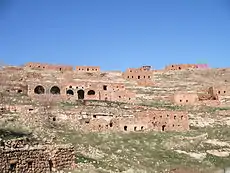Kurdish villages depopulated by Turkey
The number of Kurdish villages depopulated by Turkey is estimated at around 3,000. Since 1984, the Turkish military has embarked on a campaign to eradicate the Kurdistan Workers Party, a militant Kurdish opposition group. As a result, by the year 2000 some 30,000 people have died, and two million Kurdish refugees have been driven out of their homes into overcrowded urban shanty towns.[1][2]

Background
Much of the countryside in southeast Turkey has been depopulated by the Turkish government, with Kurdish civilians moving to local defensible centers such as Diyarbakır, Van, and Şırnak, as well as to the cities of western Turkey and even to western Europe. The causes of the depopulation included the poverty of the southeast, and the Turkish state's military operations.[3] Human Rights Watch has documented many instances where the Turkish military forcibly evacuated villages, destroying houses and equipment to prevent the return of the inhabitants. An estimated 3,000 Kurdish villages in Turkey were virtually wiped from the map, representing the displacement of more than 378,000 people.[4]
Depopulated and demolished towns and villages
According to the Humanitarian Law Project, 2,400 Kurdish villages were destroyed and 18,000 Kurds were executed, by the Turkish government. Other estimates have put the number of destroyed Kurdish villages at over 4,000. In total up to 3,000,000 people (mainly Kurds) have been displaced.[5]
The Kurdish Human Rights Project divides the depopulation (evacuation) of villages in 5 phases.[6]
- The initial phase between 1985-1989
- The phase of centralization during 1990-1991
- the phase of the systematic village evacuation between 1992-1993
- the phase of the escalation of the village evacuation in 1994
- between 1995-2001 other villages further villages were depopulated
An estimated of 1,000,000 are still internally displaced as of 2009.[7]
Government compensation
The Internal Displacement Monitoring Centre stated in 2009 that the Turkish Government has taken "notable" steps to address the internal displacement situation. These include commissioning a national survey on the number and conditions of IDPs, drafting a national IDP strategy; adopting law on compensation and putting together a comprehensive pilot action plan in Van Province and 13 other south-eastern provinces addressing rural and urban situations of displacement.[7]
References
- Ferhad Ibrahim, Gülistan Gürbey. The Kurdish conflict in Turkey: obstacles and chances for peace and democracy, Palgrave Macmillan, 2000. pg. 167. ISBN 0-312-23629-8
- Dahlman, Carl. The Political Geography of Kurdistan Archived 2008-10-03 at the Wayback Machine pg. 11
- Radu, Michael (2001). "The Rise and Fall of the PKK". Orbis. Philadelphia: Foreign Policy Research Institute. 45 (1): 47–63. doi:10.1016/S0030-4387(00)00057-0. OCLC 93642482.
- "Still critical". Human Rights Watch. March 2005. p. 3. Retrieved 2007-09-12.
- "Conflict Studies Journal at the University of New Brunswick". Lib.unb.ca. Retrieved 29 August 2010.
- Jongerden, Joost (2007-05-28). The Settlement Issue in Turkey and the Kurds: An Analysis of Spatial Policies, Modernity and War. BRILL. p. 82. ISBN 978-90-474-2011-8.
- Internal Displacement Monitoring Centre (IDMC) – Norwegian Refugee Council. "Need for continued improvement in response to protracted displacement". Internal-displacement.org. Archived from the original on 31 January 2011. Retrieved 15 April 2011.